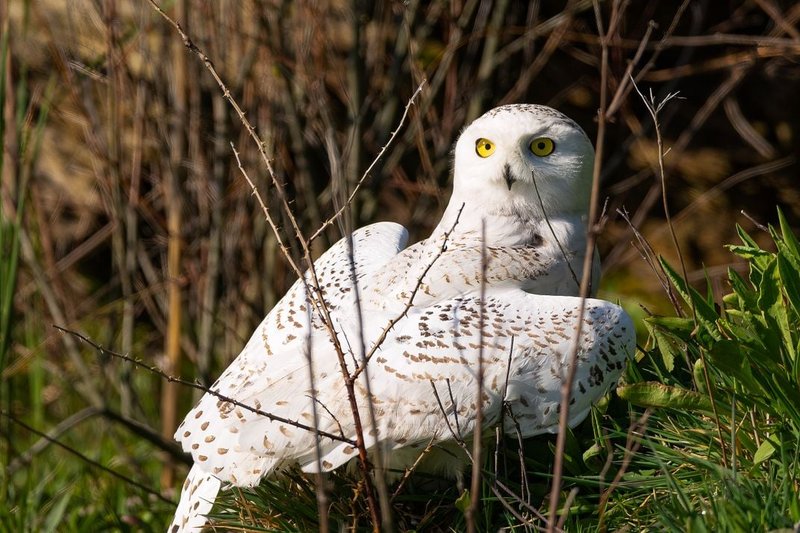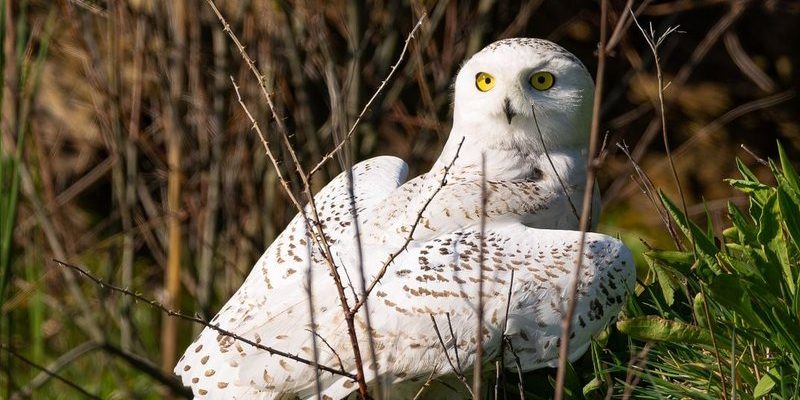
Imagine stepping into a snowy wonderland, the world blanketed in white, where a striking white bird glides gracefully through the crisp air. This bird, with its piercing yellow eyes and tufted ears, is none other than the Snowy Owl. Known for its stunning beauty and captivating presence, this owl has enchanted bird watchers and nature lovers alike. But there’s much more to the Snowy Owl than just its good looks. Let’s dive into the life of this extraordinary creature and uncover the secrets of its existence.
The Snowy Owl, famous for its role in popular culture—especially through the “Harry Potter” series—holds significant cultural and ecological importance. As winter approaches, these magnificent birds migrate to various regions in search of food, making them a subject of intrigue for ornithologists and wildlife enthusiasts. Their adaptability in harsh climates showcases the incredible survival skills that make them one of the most fascinating birds in the world. But what do we really know about them? Let’s explore.
Physical Characteristics
The Snowy Owl is a large bird, measuring around 20 to 28 inches in length, with a wingspan that can reach up to 60 inches. Their snowy feathers provide excellent camouflage against the wintry landscape, blending effortlessly into the snow. These feathers aren’t just for show; they also serve a vital purpose in insulation, keeping the birds warm in freezing temperatures. Snowy Owls have a distinctive look, with white plumage dotted with dark spots that vary in intensity. Young owls tend to have more brown mottling, giving them a slightly different appearance.
Another striking feature is their bright yellow eyes, which provide excellent vision in low-light conditions. The ocular structure of the Snowy Owl is specially adapted to help them see prey even in the dimmest light. Beyond their eyes, these owls also have a unique facial disc that aids in sound location, helping them pinpoint the source of rustling sounds in the snow as they hunt.
Habitat
Snowy Owls primarily inhabit the Arctic regions, where the landscape is characterized by vast expanses of snow and ice. They can be found in tundra environments, where they nest on the ground, often using depressions to shield their eggs from the harsh elements. During winter, these owls can migrate southward to more temperate areas, typically in search of food. This migration allows them to stretch their wings and explore habitats ranging from open fields to coastal dunes.
In recent years, Snowy Owls have been spotted in areas as far south as the northern United States, often drawn by an abundance of prey. While they prefer open habitats, they’re also known to take residence near airports and urban locations, where they can find both shelter and food. However, their migration patterns are unpredictable and can be influenced by factors such as prey availability and climate changes.
Diet and Hunting Behavior
The Snowy Owl is a formidable hunter, primarily feeding on small to medium-sized mammals, with a diet heavily reliant on lemmings. In fact, in some regions, lemmings can comprise up to 90% of their diet! During lemming population booms, Snowy Owls can thrive and even raise multiple broods in a single season. Their hunting strategy typically involves sitting still and watching for movement before swooping down to capture prey with their powerful talons.
While lemmings are a favorite, Snowy Owls also eat birds, rabbits, and rodents when necessary. Their ability to hunt effectively in low light means they are active at dusk and dawn, but they can also hunt during the day if necessary. This adaptability highlights their role as apex predators in the tundra ecosystem, keeping rodent populations in check.
Reproduction and Lifespan
Snowy Owls typically mate during the early spring months. Males will establish their territory and attract females with their distinctive hoots and displays. Once a pair forms, they will choose a nesting site, often on the ground or in a shallow depression. The female usually lays around 3 to 8 eggs, which she incubates for about 32 to 37 days, while the male provides food.
Once the chicks hatch, they are covered in down and rely heavily on their parents for food and protection. The parents work together to ensure the young owls have enough to eat, especially during the critical early stages of their lives. As the chicks grow and develop feathers, they will begin to take flight at about 10 weeks old, though they may still depend on their parents for food for some time after fledging.
The lifespan of a Snowy Owl in the wild is typically around 10 years, but some have been known to live longer, especially in captivity. Their survival largely depends on the availability of food and environmental conditions, making them susceptible to changes in their habitat.
| Characteristic | Details |
| Size | 20 to 28 inches in length |
| Wingspan | Up to 60 inches |
| Weight | 4 to 6.5 pounds |
| Diet | Lemmings, rodents, birds, rabbits |
| Lifespan | 10 years in the wild, longer in captivity |
| Habitat | Arctic tundra, open fields, coastal dunes |
Conservation Status
The Snowy Owl is currently classified as “Least Concern” by the IUCN, but that doesn’t mean they’re out of the woods. Climate change and habitat disruption are significant threats to their populations. As the Arctic warms, their breeding grounds are changing, impacting their food supply and nesting success. Increased human activity in their natural habitats can also pose risks, especially from disturbances.
Conservation efforts are underway to monitor and protect Snowy Owl populations, focusing on habitat preservation and understanding their migration patterns. Organizations dedicated to wildlife conservation actively research these majestic birds, gathering data to create more effective protection strategies. Public awareness and education about the Snowy Owl’s plight are crucial for their future.
Cultural Significance
The Snowy Owl has captivated humanity for centuries, appearing in folklore, literature, and mythology. In many Arctic cultures, they are revered as symbols of wisdom and protection. The owl’s striking appearance and silent flight have led numerous cultures to view it as an omen or guide. Popular media, especially the “Harry Potter” series featuring Hedwig, has also cemented the Snowy Owl’s place in modern culture, endearing it to a new generation.
This cultural significance often inspires conservation efforts, as people feel a personal connection to these magnificent birds. Organizations leverage this connection to promote awareness about the threats facing Snowy Owls, emphasizing the need for responsible behaviors that protect their habitats. Simply put, our fascination with these creatures can drive the commitment needed to ensure their survival.
FAQ
What is the Snowy Owl’s natural habitat?
The Snowy Owl primarily resides in Arctic tundra regions where they can find open spaces to hunt and nest. They often inhabit areas with minimal vegetation, making it easier for them to spot their prey. During the winter months, they can migrate to southern regions where they search for food, adapting to various habitats such as fields and even urban areas.
How do Snowy Owls hunt?
Snowy Owls are skilled hunters, known for their keen eyesight and silent flight. They typically perch in high spots and scan the ground for movement. Once they spot their prey, they swoop down with incredible speed, using their powerful talons to capture it. Their hunting prowess is significantly enhanced by their ability to see well in low light, allowing them to hunt at dawn and dusk.
Are Snowy Owls sociable?
Generally, Snowy Owls are solitary creatures, preferring to hunt and live alone or in pairs during the breeding season. They establish territories and can be quite territorial, especially during nesting. However, during periods of food abundance, such as during lemming population booms, they may gather in larger numbers.
What do baby Snowy Owls look like?
Baby Snowy Owls, known as chicks, are covered in fluffy down feathers that are typically white or light brown with darker markings. This camouflage helps protect them from predators. As they grow, they develop their adult plumage, which is predominantly white with distinctive dark spots, enhancing their ability to blend into the snowy landscape.
How can I help protect Snowy Owls?
You can help protect Snowy Owls and their habitats by supporting conservation organizations dedicated to wildlife protection. Staying informed and raising awareness about their natural history and the challenges they face is vital. Also, being responsible in your outdoor activities, avoiding disturbance to nesting areas, and advocating for environmental conservation can make a significant difference.
What is the Snowy Owl’s range?
The Snowy Owl’s range primarily includes the Arctic regions of North America and Eurasia. They breed in the high Arctic, and during winter, they can migrate south into parts of Canada and the United States. Their migratory patterns can fluctuate based on prey availability and environmental conditions, sometimes resulting in unexpected sightings far from their usual territory.
Do Snowy Owls mate for life?
Snowy Owls do not form lifelong pair bonds, but they typically mate for the breeding season. Once a breeding pair is formed, they will work together to raise their young. After the nesting season, they go their separate ways, potentially finding new partners during the next breeding season.
What sounds do Snowy Owls make?
Snowy Owls are not overly vocal, but they do produce a variety of sounds, especially during the breeding season. Common vocalizations include hoots, barks, and hisses. Males often use a series of hoots to attract females or defend their territory, while females may make softer sounds when caring for their young.
What are the biggest threats to Snowy Owls?
Major threats to Snowy Owls include habitat loss due to climate change, reduced food availability from declining prey populations, and human disturbances. Climate change impacts their breeding habitat and food sources, while urban development can lead to collision risks and loss of nesting sites. Conservation efforts aim to address these challenges and promote the protection of their habitats.
Can Snowy Owls be kept as pets?
Snowy Owls are wild animals and are not suitable as pets. They require large territories, specific diets, and natural habitats to thrive, which cannot be replicated in a home environment. Additionally, keeping wild birds as pets is often illegal and unethical. It is essential to respect their natural behaviors and habitats and support their conservation in the wild.

